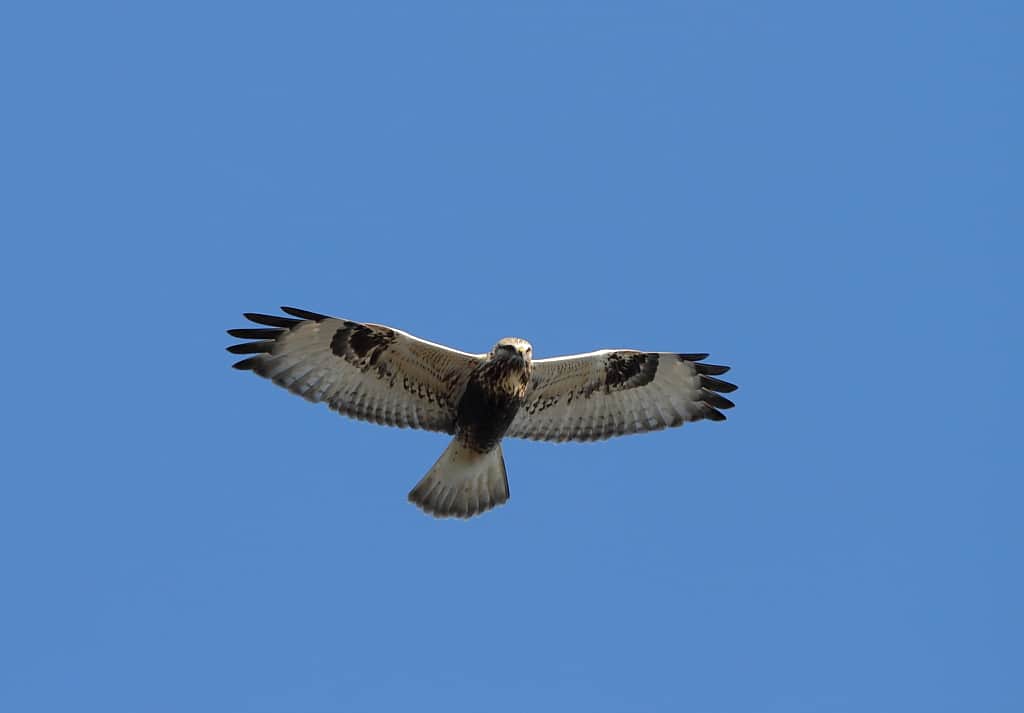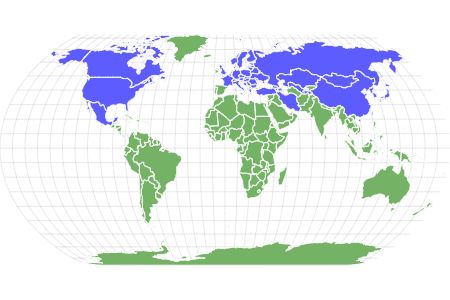Rough-Legged Hawk (Rough-Legged Buzzard)
Buteo lagopus
Its scientific name, lagopus, is Ancient Greek for “hare” and “foot,” referring to its feathered feet and toes.
Advertisement
Rough-Legged Hawk (Rough-Legged Buzzard) Scientific Classification
- Kingdom
- Animalia
- Phylum
- Chordata
- Class
- Aves
- Order
- Accipitriformes
- Family
- Accipitridae
- Genus
- Buteo
- Scientific Name
- Buteo lagopus
Read our Complete Guide to Classification of Animals.
Rough-Legged Hawk (Rough-Legged Buzzard) Conservation Status
Rough-Legged Hawk (Rough-Legged Buzzard) Facts
- Prey
- Small rodents and passerine birds
- Main Prey
- Lemmings, voles
- Name Of Young
- Eyas
- Group Behavior
- Mainly solitary
- Fun Fact
- Its scientific name, lagopus, is Ancient Greek for “hare” and “foot,” referring to its feathered feet and toes.
- Estimated Population Size
- 350,000 to 800,000
- Biggest Threat
- collisions, accidental capture from bear traps, pesticides
- Most Distinctive Feature
- Bold patterns, M-shaped wings
- Distinctive Feature
- Feathers legs and feet
- Wingspan
- 47 to 60 inches
- Incubation Period
- 31 days
- Age Of Independence
- 8 to 10 weeks
- Age Of Fledgling
- 4 to 6 weeks
- Habitat
- Arctic tundra and coasts, open grasslands
- Predators
- Birds of prey, Arctic foxes, brown bears, wolverines, skuas
- Diet
- Carnivore
- Lifestyle
- Diurnal
- Favorite Food
- Small rodents
- Type
- Bird
- Common Name
- Rough-legged hawk
- Special Features
- Small talons
- Number Of Species
- 2
- Location
- North America, Europe, Asia
- Nesting Location
- Exposed cliffsides, high trees, buildings
- Migratory
- 1
View all of the Rough-Legged Hawk (Rough-Legged Buzzard) images!
“Their habitats include tundra and Arctic coasts during the breeding season.”
Summary
The rough-legged hawk (Buteo lagopus), also known as the rough-legged buzzard, lives on three continents across 50 countries. It inhabits the Arctic tundra during spring and summer and open grasslands and prairies during the winter. This hawk has unusual adaptations, such as feathered feet and rapid wing beats, allowing it to hover in place. Learn all the interesting facts about the rough-legged hawk, including where it lives, what it eats, and how it behaves.
5 Amazing Rough-legged Hawk Facts
- The rough-legged hawk builds its nest using Arctic plants and caribou bones, lining it with feathers and fur.
- Its scientific name, lagopus, is Ancient Greek for “hare” and “foot,” referring to its feathered feet and toes.
- They have loud alarm calls that sound like cat “mews.”
- They are the only hawk species that can hover in one spot by rapidly beating their wings.
- Their favorite food is rodents and small birds. They will also steal food from other raptors.
Where to Find the Rough-legged Hawk
Rough-legged hawks live in North America, Europe, and Asia in over 50 countries, including Canada, The United States, France, Germany, and China. They breed in Arctic and Subarctic regions and migrate south for the winter, as far as the Central United States, Southern Europe, and Asia. You can find them as far south as Texas in the United States, and they are typically absent from the Southeast. Their habitats include tundra and Arctic coasts during the breeding season. But they spend their winters in open country like grasslands, coastal prairies, marshes, farmlands, and dunes.
Rough-legged Hawk Nest
Males choose exposed cliffsides, high trees, or buildings for their nest sites. Males collect the materials, while females spend three to four weeks building a bulky platform consisting of Arctic plants and caribou bones. She lines the insides with grass, feathers, and fur. This species may reuse the same nest for several breeding seasons.
Scientific Name
The rough-legged hawk (Buteo lagopus) is from the Accipitriformes order in the Accipitridae family, encompassing small to large birds with strongly hooked bills. The Buteo genus comprises the hawks in North America and the buzzards in Europe. Its specific name, lagopus, is Ancient Greek for “hare” and “foot,” reflecting its feathered feet.
There are three recognized subspecies of rough-legged hawks:
- B. l. Lagopus: Northern Europe and Asia
- B. l. Sanctijohannis: North America
- B. l. Kamtchatkensis: North Siberia to Pacific North America
Size, Appearance, & Behavior

The rough-legged hawk (Buteo lagopus), also known as the rough-legged buzzard, lives on three continents across 50 countries.
©1,024 × 713 pixels, file size: 355 KB, MIME type: image/jpeg – License
The rough-legged hawk is a relatively large bird of prey, measuring 18 to 24 inches long and weighing 1.32 to 3.66 pounds, with a 47 to 60-inch wingspan. They have long, narrow wings (compared to other hawks), which creates a slight M-shape mid-flight. These hawks are dark brown with bold patterns, and their tails are dark at the tips and pale at the base. They occur in light and dark morphs, similar to other hawk species. Their evolutionary adaptations consist of small talons to catch their prey of choice and feathered feet and toes to withstand the cold Arctic regions.
This species is primarily solitary but forms monogamous pair bonds during the breeding season and may migrate alone or with small groups. Rough-legged hawks have an unusual feature: they beat their wings rapidly and hover over one spot while hunting. However, their exact speed is unknown. Their alarm calls are loud and cat-like, lasting several seconds and repeating. And their typical calls are whistles with a descending scale. Both can be made while perched or in flight.
Migration Pattern and Timing
They are medium-distance migrants who breed in the tundra and boreal forests in the northern regions of North America and Eurasia. Populations in North America migrate to Southern Canada and the Central United States during winter. And those in Eurasia migrate to Southern Europe and Asia.
Diet
The rough-legged hawk is a carnivore and an opportunistic hunter. Small mammals make up 62 to 98% of their diet.
What Does the Rough-legged Hawk Eat?
Their diet primarily consists of small rodents, such as lemmings, voles, mice, rats, gerbils, shrews, and squirrels. Birds are their second favorite type of prey, mainly passerines like buntings and sparrows. They occasionally prey on larger birds, such as waterfowl and short-eared owls. They may resort to eating larger mammals like jackrabbits and prairie dogs when food is scarce. Rough-legged hawks are opportunistic and aggressive hunters, often stealing prey from their own species and other raptors. They hunt during the day and either watch prey from a stoop before stooping or catch it mid-flight. Unlike most birds of prey, these hawks hover above the ground while searching for food.
Predators, Threats, and Conservation Status
The IUCN lists the rough-legged hawk as LC or “least concern.” Due to its extensive range and very large, stable population, this species does not meet “threatened” status thresholds. However, this species faces several threats. Historically, it was significantly threatened by shooting and trapping but is no longer a severe hazard. Its other threats include collisions, accidental capture from bear traps, pesticides, and the effects of climate change like fluctuating weather and increased rainfall. Weather changes can cause unsuccessful reproduction and collapsed nests.
What Eats the Rough-legged Hawk?
Several animals prey on rough-legged hawk nests, such as Arctic foxes, brown bears, wolverines, ravens, skuas, and snowy owls. Adult hawks have very few natural predators but may die in conflicts with other raptors like eagles, falcons, owls, and other hawks. Like other birds of prey, Rough-legged hawks are defensive of their territories. They give alarm calls and will drive off intruders to protect their nests and areas.
Reproduction, Young, and Molting
Rough-legged hawks reach sexual maturity at two years and form monogamous pair bonds, mating with the same partner for several years, perhaps for life. They begin looking for their nesting territories during the fall, and breeding occurs during May. Females lay an average of three to five eggs and incubate them for 31 days, while the males bring food. The young fledge the nest four to six weeks after hatching but depend on their parents for food for another two to four weeks. Their average lifespan is 7.5 years, but they can live up to 18 years.
Population
The global rough-legged hawk population is estimated to number 350,000 to 800,000 mature individuals. Its European and North American populations are currently stable and have been since the 1970s. However, groups in some areas may fluctuate depending on the availability of small mammals as a food source.
Related Animals:
View all 114 animals that start with RRough-Legged Hawk (Rough-Legged Buzzard) FAQs (Frequently Asked Questions)
Are rough-legged hawks rare?
Rough-legged hawks have a very large population but are rare to spot due to their Arctic habitats.
How can you tell a rough-legged hawk?
They have long, narrow wings (compared to other hawks), which creates a slight M-shape mid-flight. These hawks are dark brown with bold patterns, and their tails are dark at the tips and pale at the base.
Why is it called rough-legged hawk?
They have feathered legs and feet down to their toes. This is uncommon for hawk species.
Where do rough-legged hawks live?
Rough-legged hawks live in North America, Europe, and Asia in over 50 countries, including Canada, The United States, France, Germany, and China. Their habitats include Arctic tundra and open grasslands.
How big do rough-legged hawks get?
The rough-legged hawk is a relatively large bird of prey, measuring 18 to 24 inches long and weighing 1.32 to 3.66 pounds, with a 47 to 60-inch wingspan.
What do rough-legged hawks sound like?
Their alarm calls are loud and cat-like, lasting several seconds and repeating. And their typical calls are whistles with a descending scale.
Do rough-legged hawks migrate?
They are medium-distance migrants who breed in the tundra and boreal forests in the northern regions of North America and Eurasia. The migrate south to Southern Canada, the Central United States, Southern Europe, and Asia.
What do rough-legged hawks eat?
Their diet primarily consists of small rodents, such as lemmings, voles, mice, rats, gerbils, shrews, and squirrels. Birds are their second favorite type of prey, mainly passerines like buntings and sparrows.
What threatens the rough-legged hawk?
Its threats include hunting, collisions, accidental capture from bear traps, pesticides, and the effects of climate change.
Thank you for reading! Have some feedback for us? Contact the AZ Animals editorial team.
Sources
- Red List / BirdLife International, Available here: https://www.iucnredlist.org/species/22695973/202640529
- JSTOR / The Condor, Available here: https://www.jstor.org/stable/1364791
- Oxford Academic / The Auk / Andréanne Beardsell, Gilles Gauthier, Jean-François Therrien, Joël Bêty, Available here: https://academic.oup.com/auk/article/133/4/718/5149267

















